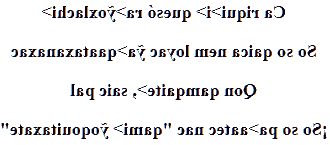Mocoví love poem
Na˃ỹoxlate
Ca riqui˃i˃ quesó ra˃ỹoxlachi˃
So so qaica nem loyac ỹa˃qaataxanaxac
Qon qamqaite˃, saic pal
¡So so pa˃aatec nac "qami˃ ỹoqouitaxate"


→ French poem ←
Moqoit language
Find here my little love poem translated into Mocoví (other names: Moqoit, Bocovíes, Mosobíes, Amocobies, Amokebit, Mocobí, Moncobys, Mbocobí, Mokowitt, Mocoit, Mokovi, Mokoilasseek, Mokovit, Mbokobí, Moscovi), in a language spoken in southern Chaco, and central and northern Santa Fé, Argentina.
moqoit la’qaatqa is a southern Waikurúan language, used daily by approximately 5,000 Mocoví Indians.
If this language is official in the province of Chaco, where efforts are made to preserve it, in that of Santa Fé where bilingualism is in progress, it remains the prerogative of the elders, and the younger ones prefer Spanish.
The language first written by missionaries is based on Spanish spelling. It was not until the middle of the 20th century that really start the creation of schools to teach Spanish.
Moscovi Indians
The Mocovi Indians upon the arrival of the Spaniards were nomadic hunter-gatherers who moved in small groups of extended families between the Bermejo and Salado rivers.
They were in contact with the Inca villages with which they practiced barter.
When the Spaniards began to enter their territory it was to create missions and colonies. It was really only from the beginning of the 20th century that a real colonization would take place, pushing the Mocovis to settle down and change their way of life, also because of an ever increasing deforestation.
Protests followed by brutal repressions will eventually transform their society.
Mbaya